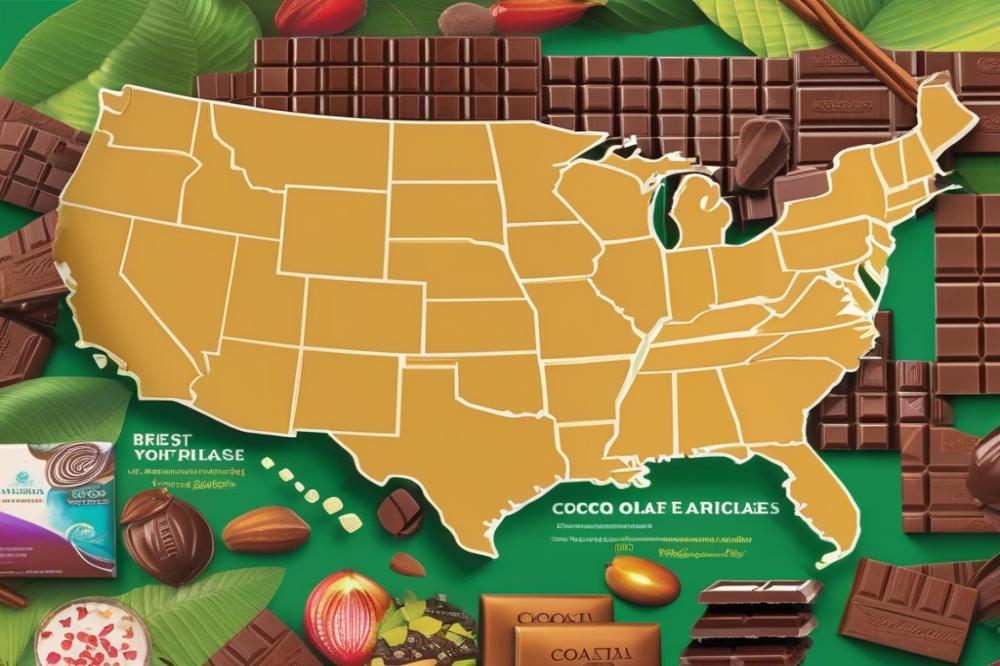Introduction
The US chocolate industry plays a significant role in the economy. This sector generates billions of dollars each year and supports countless jobs across various fields. Chocolate is not just a treat; it’s deeply woven into the culture and daily lives of many Americans. From heartwarming gifts to everyday snacks, its appeal is universal.
A diverse workforce underpins this industry. Agricultural workers initially grow cocoa beans, the essential ingredient for chocolate. These farmers face challenges, including climate change and market fluctuations. After harvesting the crops, the journey of cocoa begins.
Production workers transform raw cocoa into chocolate through complex processes. At this stage, chocolate manufacturing is crucial. Workers ensure the right blend and consistency through precise techniques. Confectionery workers use their skills to create everything from bars to delicate truffles. Quality control experts play an essential role in monitoring products to maintain high standards.
The supply chain management aspect also demands attention. It involves overseeing every step, from cocoa farms to retail shelves. Companies must navigate logistics and ensure timely delivery of materials and products. Marketing teams then highlight the unique qualities of their chocolates to attract customers.
With retail staff at the final stage, they connect products with consumers. They create a welcoming atmosphere and provide information about offerings. These chocolate industry jobs contribute to a vibrant community centered around sweet indulgences.
Understanding the roles within the US chocolate industry workforce reveals the collaboration and expertise needed to satisfy chocolate lovers. Each job, from farming to sales, plays an important part in making chocolate readily available. This industry is not just about creating chocolate; it is about a vast network of dedicated individuals working together.
The Size of the US chocolate industry workforce

The chocolate industry in the United States is substantial. Around 150,000 individuals are employed directly in various sectors. These roles can be found in chocolate manufacturing, cocoa farming, retail, and other areas.
Everyone enjoys chocolate, but many may not realize the people behind it. Within the chocolate manufacturing sector, you’ll find production workers who create the products consumers love. These hands-on roles are essential for keeping the factories running efficiently.
Not only do production workers contribute, but quality control staff also play a significant role. They inspect products to maintain high safety and quality standards. This task is critical for consumer trust and product satisfaction.
In the realm of cocoa farming, agricultural workers are vital to the process. They cultivate and harvest the cocoa beans that are foundational for chocolate. Their hard work on farms ensures that manufacturers have the raw materials needed.
Retail staff serve as the face of the industry. They work in stores and shops, selling chocolates and engaging with customers. Their ability to connect with buyers contributes greatly to the chocolate’s appeal.
Additionally, the industry employs confectionery workers, who specialize in creating various treats. From truffles to candy bars, their creativity showcases chocolate’s versatility. Supply chain management professionals coordinate the movement of products, ensuring everything flows smoothly from farms to stores.
The chocolate industry is larger than many realize. When compared to other food industries, it has a significant workforce. The candy industry as a whole employs hundreds of thousands, showcasing the broader impact of sweet treats.
Food scientists also find roles within chocolate companies. They research and develop new recipes or improve existing products. This field is innovative, continuously pushing the boundaries of flavor and texture.
Working in the chocolate world is diverse. Each role, big or small, helps create beloved chocolate products enjoyed by many. The blend of agricultural, manufacturing, and retail jobs makes for a dynamic workforce that supports this tasty industry.
Key Roles in Chocolate Manufacturing

Production workers play a crucial role in chocolate manufacturing. These employees are responsible for transforming raw ingredients into the sweet treats we enjoy. Their daily tasks often include mixing, molding, and packaging chocolate products. Much of the process is fast-paced, requiring workers to stay focused and efficient.
Quality control personnel are essential for maintaining high standards in the industry. They monitor the entire production process, testing samples to confirm that every batch meets safety regulations and taste expectations. Their insights help to catch any issues before products reach consumers. Any deviation from the standard can lead to big problems, so their role is paramount.
The contribution of food scientists cannot be overlooked either. These specialists dedicate their knowledge to developing innovative chocolate products. They experiment with flavors and textures, aiming to create enjoyable and marketable items. In addition, food scientists study how ingredients interact to optimize formulations for both taste and shelf life.
In addition to these roles, professionals in supply chain management ensure that everything runs smoothly—from cocoa farming to the store shelf. Retail staff often engage directly with customers. Their insights help companies understand consumer preferences, while confectionery workers add creativity and artistry to the chocolate-making process.
Agricultural workers grow the cacao plants that provide the essential ingredient for chocolate. Their work lays the groundwork for the entire industry. Without their labor, chocolate production would not be sustainable. Each of these roles contributes to the vibrant tapestry that defines the chocolate industry in the United States.
Cocoa Farming and Agricultural Workers
Cocoa farming is a crucial part of the chocolate industry in the United States. While much of the world’s cocoa is grown in tropical regions, some U.S. farms are starting to experiment with cultivation. States like Florida and Hawaii have begun to plant cocoa trees. These efforts are still limited but show promise for the future.
Agricultural workers play a key role in maintaining cocoa farms. They manage the nurturing of cocoa trees and oversee the harvesting of cocoa pods. These workers are responsible for ensuring optimal growth, which directly affects the quality of the chocolate produced. After harvesting, the cocoa beans must be fermented, dried, and prepared for shipment. These steps rely on skilled labor to maintain quality control standards.
Several challenges cloud the future of cocoa farming in the U.S. Climate change threatens to disrupt growing conditions. Unpredictable weather patterns can lead to poor crop yields. Additionally, the workforce faces issues related to sustainability, such as fair wages and labor rights. Many agricultural workers endure harsh conditions without adequate compensation.
Cocoa farming also connects with other sectors in the chocolate industry. It affects everything from chocolate manufacturing to retail staff who sell the final products. Effective supply chain management is essential for getting cocoa from farm to factory. Confectionery workers must often work closely with agricultural experts to create high-quality chocolates.
Food science has emerged as an important field in understanding cocoa quality. Researchers study varieties of cocoa plants to determine which ones thrive best in the U.S. Innovations in growing techniques can also help improve yield. Workers on the ground contribute valuable insights based on their experiences with the plants.
Ultimately, the future of the cocoa industry depends on collaboration among various groups. Agricultural workers must be supported to grow coffee sustainably. Consumer awareness about the challenges faced by farmers can also make a difference. If people understand where their chocolate comes from, they may choose brands that prioritize fair labor practices.
Confectionery Workers and Production Processes
The chocolate industry in the United States heavily relies on confectionery workers. These individuals play crucial roles in the production of chocolate products. From extensively trained chocolate makers to highly skilled production workers, each person contributes to the final product. Their tasks often consist of blending ingredients, cooking mixtures, and molding chocolate into various shapes.
Chocolate manufacturing is not a simple task. It involves several complex processes that begin with cocoa farming. Agricultural workers cultivate cocoa beans, ensuring they grow in the right conditions. Once harvested, these beans must be fermented, dried, and roasted. This entire process impacts the flavor and quality of the resulting chocolate.
After beans are roasted, confectionery workers step in. They grind the roasted beans into cocoa mass or liquor. This step is vital as it creates the base for all chocolate products. Following this, the chocolate mass can be refined and blended with sugar and other ingredients. Each of these actions is performed with attention to detail and quality control measures in place.
Moreover, skilled labor is essential throughout the production line. Quality control staff monitor the chocolate at various stages. They ensure that the ingredients are mixed properly and that the final product meets industry standards. This attention to quality enhances the taste and texture, which is what consumers look for in chocolate.
The journey of chocolate doesn’t end with manufacturing. Supply chain management plays a significant role as well. This department coordinates the movement of ingredients from farms to factories. Retail staff also engage with customers, explaining products and answering questions. Their connection to people helps to maintain the brand image and customer satisfaction.
Food science plays a notable role in this industry too. Innovations in processing and ingredient use can create healthier or even more delightful chocolate options. The unique skills of workers in this field can lead to new tastes and products that excite consumers. Continued research and development ensure that the industry evolves with consumer preferences.
Lastly, marketing efforts help to promote different chocolate brands and products. These campaigns inform potential buyers about what’s available. Whether it be through TV ads or online social media, the story of chocolate is shared widely. This aspect is essential to driving sales and expanding reach.
Supply Chain Management in the Chocolate Industry
Supply chain management plays a crucial role in the chocolate industry. It covers everything from cocoa farming to the delicious treats found on store shelves. Various professionals collaborate to move raw materials and finished products efficiently. Farmers grow cocoa beans, and these agricultural workers lay the foundation for the entire chocolate creation process.
Once harvested, cocoa beans travel to manufacturers. Here, production workers take charge of turning raw ingredients into the chocolate we all know and love. This part of the process requires careful attention to detail, as quality control personnel play a vital role in monitoring the process. They ensure that every batch meets the necessary standards for flavor and safety.
Logistics and distribution personnel are essential in this industry. After production, they manage how chocolate moves from factories to retailers. Their task involves planning efficient routes and managing transportation. Without their expertise, products might arrive late or spoil during transit, resulting in financial losses.
Marketing teams help build brand recognition and promote new products. They work hand in hand with retailers to create attractive displays and generate consumer interest. Retail staff then engage with customers, providing insights about the products. This interaction is key to understanding what consumers desire.
The interplay between farmers, manufacturers, and retailers defines the chocolate supply chain. Each segment relies on the others for a smooth operation. For instance, manufacturers depend on farmers for high-quality cocoa. If the supply of cocoa diminishes or is inconsistent, it can disrupt the entire production process.
In summary, the chocolate industry’s supply chain is complex and interconnected. Each role is significant, from cocoa farming to confectionery workers. Together, they ensure that consumers enjoy their favorite chocolate products with every bite.
Marketing and Retail Staff
Marketing plays a vital role in the chocolate sector. It is necessary for promoting various chocolate products. Professionals in this field develop strategies to attract consumers. Their aim is to showcase the taste, quality, and uniqueness of each brand. Promotions often include advertisements on social media platforms, television, and even print. They analyze trends in consumer behavior to fine-tune their messaging and campaigns.
In the retail space, employees contribute significantly to sales and customer service. Retail staff engage directly with consumers, offering advice and assistance. They understand the importance of creating positive shopping experiences. Knowledge about different products helps them recommend items to customers. This personal touch can lead to increased sales. Happy customers are likely to return, ensuring brand loyalty.
Recent trends show a shift in how chocolate is marketed. There is growing demand for sustainable and ethically sourced products. As a result, many companies highlight their commitment to cocoa farming with ethical practices. Engaging stories about where ingredients come from resonate with consumers. Social media has become a powerful tool for connecting with audiences. Brands are now using influencers and interactive campaigns to attract attention.
Customer satisfaction is crucial in both marketing and retail. Feedback from shoppers can guide future marketing efforts. Retailers monitor sales patterns and shifts in consumer preferences closely. This information helps both marketing teams and managers make informed decisions. The entire process supports the larger chocolate manufacturing ecosystem. It includes not only marketing and retail efforts but also production workers and supply chain management.
Understanding food science is increasingly important in advertising chocolate. Marketers need to be familiar with ingredients and health trends. This knowledge aids in crafting messages that appeal to health-conscious consumers. Educational campaigns about cocoa benefits are becoming more common. This type of engagement fosters deeper connections with the audience.
Overall, marketing and retail staff are critical in the chocolate industry. Their abilities to communicate, sell, and build relationships form the backbone of the market. Many people working in marketing and retail are passionate about chocolate. They thrive on creativity in representing their brands and ensuring customers feel valued.
Future Trends and Workforce Challenges
The US chocolate industry faces several challenges that could impact its workforce. Labor shortages have become a pressing issue. Many companies struggle to find skilled workers for chocolate manufacturing. Production workers are essential for keeping operations running smoothly.
Fluctuations in demand can also create problems. During holiday seasons, the need for confectionery workers increases dramatically. However, after the holidays, the need drops sharply. This inconsistency makes planning for workforce needs difficult. Employers often face the dilemma of hiring seasonal staff versus maintaining a steady team.
Cocoa farming is another key area impacted by workforce trends. Many agricultural workers are aging, and younger generations show less interest in these jobs. As a result, finding new talent in farming becomes crucial. Future cocoa production might rely more on technology than on manual labor.
Skills will need to evolve alongside these changes. Knowledge in food science will grow in importance. Understanding changes in consumer preferences will be critical for marketing professionals. In addition, expertise in supply chain management is becoming vital due to global trade dynamics.
Retail staff will also play a significant role in shaping the industry’s future. Their ability to engage with customers can affect sales directly. Training in customer service and product knowledge will be essential for success.
Overall, the chocolate industry will continue to face both opportunities and obstacles. A skilled, adaptable workforce will be necessary to meet upcoming challenges. Keeping the workforce engaged and trained will take consistent effort from industry leaders. The future depends on attracting new talent and embracing changes in technology.
Final Thoughts on the US Chocolate Industry Workforce
Understanding the Roles
Throughout the chocolate industry, many roles are crucial for success. From cocoa farming to chocolate manufacturing, each part plays a vital role. Farmers grow cocoa beans, while factory workers transform these beans into delicious products. Quality control inspectors ensure that the final products meet high standards. Marketing specialists help bring chocolate to consumers and highlight its unique qualities.
The Importance of Each Sector
Every sector contributes to a thriving chocolate industry. Cocoa farmers lay the foundation by providing raw materials. Factory workers apply their skills to create products that people love. Quality inspectors maintain product integrity, which is essential for customer satisfaction. Marketing teams attract new customers, driving sales and expanding the market. All these roles interact to create a successful chocolate supply chain. Their efforts make chocolate a beloved treat across the country.
Looking to the Future
The future of the chocolate industry hinges on sustainability and innovation. Workers must adapt to changes such as eco-friendly practices and new technologies. With consumer demands shifting, the industry should focus on sustainable farming methods and ethical sourcing. There is a growing need for trained professionals who understand both traditional and modern techniques. This evolution will shape the workforce over time, preparing it for new challenges and opportunities.
In summary, understanding the various roles and their contributions enriches our appreciation of the chocolate we consume. Each person in the chocolate-making process plays a part in its journey from bean to bar. Looking ahead, embracing sustainability will be key for the industry’s growth and longevity. The workforce will remain essential in navigating the changing landscape of chocolate production.



